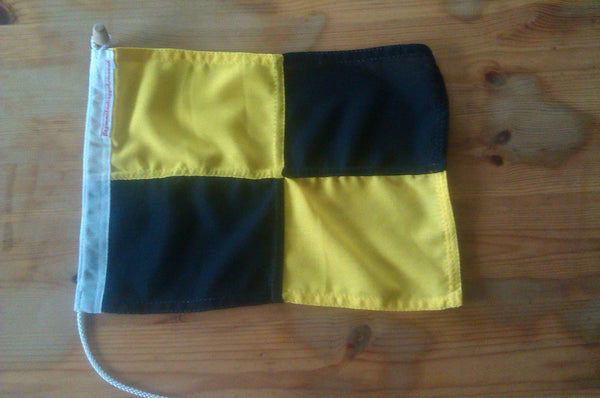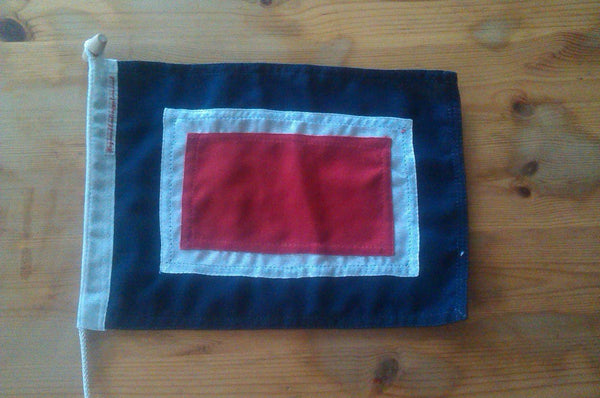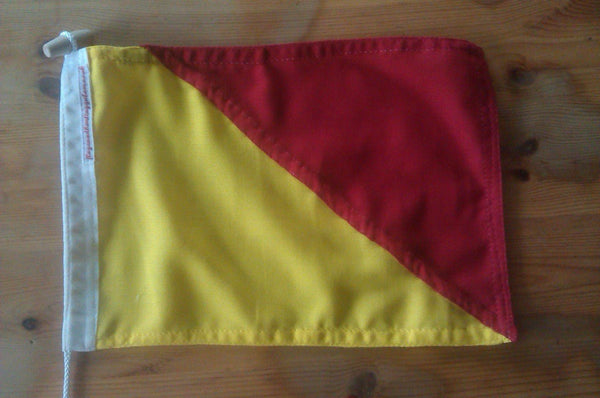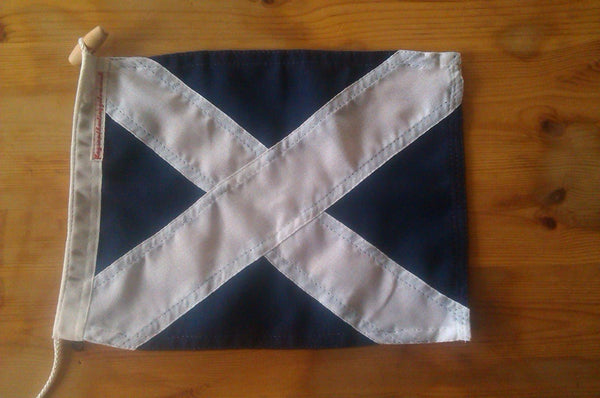International code of signals
The purpose of the International Code of Signals is to provide ways and means of communication in situations related essentially to safety of navigation and persons, especially when language difficulties arise. It has done this by first establishing a standardized alphabet (the letters A to Z and the ten digits), along with a spoken form of each letter (to avoid confusing similar-sounding letters, such as 'b', 'p', and 'v'), and associating this alphabet with standardized flags.
Combinations of these alphanumeric characters are assigned as codes for various standardized messages. For instance, the master of a ship may wish to communicate with another ship, where their own radio may not be working or the other ship's call sign is not known or the other ship may not be maintaining a radio watch. One simply raises the Kilo flag (see diagram at the top), or sends the Morse Code equivalent (dash-dot-dash) by flashing light; this has the assigned message of "I wish to communicate with you."
One practical application of the ICS is that all of the standardized messages come in nine languages (English, French, Italian, German, Japanese, Spanish, Norwegian, and, since 1969, Russian and Greek). This fact is immaterial if the sender and receiver(s) are using different languages; each language has a book with equivalent messages keyed to the same code. This is also useful in radiotelephony, or even when ships are within hailing distance, if there is no common language: a crew member on a burning ship yells "yuliett alfa vour", and a vessel coming to their aid knows exactly what they need ƒ?? "material for foam fire extinguishers" (that is, the foaming agent).
The code also covers procedural aspects (how to initiate a call, the format of a message, how to format date and time, etc.), how naval ships (which usually use their own codes) indicate that they are using the ICS (by flying the code pennant), use in radiotelephony (use of the spoken word "Interco"), and various other matters (such as how an aircraft directs a vessel to another vessel in distress and how to order unidentified submarines to surface).
Signals
In some cases, additional characters are added to indicate quantities, bearing, course, distance, date, time, latitude, or longitude. There is also provision for spelling words and for indicating use of other codes. Several of the more common single-letter signals are shown at the right. Two-letter signals cover a broad gamut of situations.
Repeated characters can be a problem in flag hoist. To avoid having to carry multiple sets of signal flags, the Code uses three "substitute" (or "repeater") flags. These repeat the flag at the indicated position. For instance, to signal MAA ("I request urgent medical advice" the Mike, Alfa, and 2nd substitute flags would be flown, the substitute indicating a repeat of the second character.


| ¶ÿSize | 0 | 2 | 3 | 7 | 10 | 14 |
| Flags | 12x15" | 18x24" | 24x24" | 36x36" | 48x48" | 48x72" |
| Pennants | 8x24" | 16x36" | 16x36" | 24x54" | 32x72" | 32x108" |
| Substitutes | 8x16" | 12x24" | 16x28" | 24x48" | 32x64" | 32x64" |
| Canvas sleeve (open ends) | ||||||
| Canvas rope and toggle |
First class flags - guaranteed
We make and supply flags of every size, description and design to clients worldwide- no order too small.
The design and creation of custom one off design flags is our speciality.
Flag design
We have the artwork for all national and generic flags on file, so there are no hidden charges for their use, nor are they covered by any trademark restrictions.
For us to make a flag of your specific choice of design we will need to create the artwork for you (if you haven’t had this done already). Please refer to the Artwork Guidelines link in the footer of our website for more information.
No obligation quotes
All quotes are supplied with no obligation and are valid up to 14 days.
Flag finish
Each flag is made to order and finished with a strong canvas, cored rope and ash wood toggle with triple sewn fly end as standard.
Other finishes include top and bottom loop, Dring/s, Inglefield brass clips, extra length halyard… available on request.
Terms and conditions
Our terms are payment before production by bank transfer or by card via an emailed payment link. We also accept cheques. We don’t take card payments over the phone, sorry.
The link to the full terms and conditions of doing business with us is located in the footer section of our website.
Flag sizes and dimensions
The measurements listed on our website are rounded up and down to the point 5 when converted from inches to cms. Flags are traditionally measured in Imperial units, so inches take priority over cms. Your flag will be generously made to the inch format. Measurements listed are for guidance – we can make any size as we create from scratch.
Please note that the MOD specification fabric is only available in a max width of 1.5m, so if the STITCHED flag you require is bigger than the fabric allows, a central seam (either vertically or horizontally) will be incorporated into the flag design.
Fully stitched, part stitched part printed or fully printed
Where flags are fully STITCHED with detail, applique is sewn through in layers giving a sewn mirror image on reverse. We use Ministry of Defence specification woven polyester as standard - this replaced the traditional wool and linen/cotton mix fibre fabric in and around the 1980s and has a matt finish and a strength and durability which lasts longer than previous natural fibre fabrics. The colours are dense and strong.
Please refer to the 'fabric we use' section in the footer of our website to see the stock colours available where we also talk about the linens and other fabrics we use.
Where flags are part-SEWN part-PRINTED, Ministry of Defence specification woven polyester ground (base) is stitched and hemmed and the detail (badge, emblem etc.) is printed twice to cotton LIMA poplin fabric and stitched to each side of the flag around the detail facing left to right on the front and mirror image on the reverse unless otherwise requested.
Where flags are fully PRINTED, the format is single layer, printed through with mirror image on reverse to a strong knit polyester. Printed flags are slightly opaque in appearance.
PLEASE NOTE that our strong knit polyester is NOT to same as what retailers and other manufacturers describe as 'economy' flag fabric (roughly translating to inexpensive and not likely to last more than a few days at best). We print our flags using a sublimation heat process which prints and melts through the fibres to give a crisp and clean image on both sides, mirror image on reverse. Our flags are automatically double sided.
What does it all mean?
Please refer to the glossary page to clarify any terms you are unsure of. Use the search button at the top left of the website to search all other info throughout the site.
Thank you for your interest in Flag Studio - click the chat button for any further assistance needed - we're here to help.










